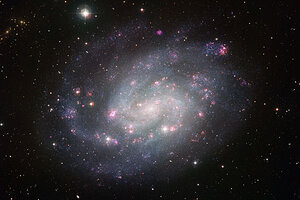Astronomers view galaxy just like our own, but with huge pink clouds
Located about 6 million light-years away, the spiral galaxy NGC 300 has many star-forming regions, which appear as pink or red spots.

This European Southern Observatory handout photo shows NGC 300, a spiral galaxy similar to the Milky Way, and located in the nearby Sculptor Group of galaxies.
ESO/AFP/Newscom/File
The wispy arms of a spiral galaxy similar to our own Milky Way can be seen in striking detail in a new image from the European Southern Observatory.
NGC 300, located in the Sculptor Group of galaxies about 6 million light-years from Earth, was photographed by the Wide Field Imager (WFI) at ESO's La Silla Observatory in Chile. [New photo of galaxy NGC 300.]
The many energetic star-forming regions along NGC 300's spiral arms are visible in the picture as red and pink clouds.
IN PICTURES: Where stars form
The image, which was taken with a 50-hour exposure, gives a clear view of NGC 300's structure and shows the apparent size of the galaxy, which is about two-thirds the size of the full moon against the sky.
NGC 300 was discovered by Scottish astronomer James Dunlop, who spotted the bright galaxy from Australia in the early 19th century. As a relatively nearby galaxy that is quite prominent in the southern skies, NGC 300 actually can be seen with regular binoculars.
The galaxy is located in the constellation Sculptor, which contains a few bright stars but is made up of a collection of galaxies that form the Sculptor Group. Other known galaxies that belong to this group include NGC 55, NGC 253 and NGC 7793.
The new image was assembled from a series of separate images that were taken through different filters with a total exposure time of close to 50 hours. The resulting data were collected over the course of many nights of observation that spanned several years.
The extensive observational campaign was part of a larger effort to assemble a census of the stars in the galaxy. Astronomers wanted to count the number and varieties of the stars while singling out regions or individual stars for more focused examination.
In a recent discovery by ESO astronomers, one of the most massive black holes was found in the galaxy, and it was determined that NGC 300 and another galaxy, NGC 55, are slowly spinning around and toward each other, in the early stages of an eventual galactic merger.
By studying the structure and content of NGC 300, astronomers can get a better idea of other characteristics of spiral galaxies like our own Milky Way.
IN PICTURES: Where stars form
